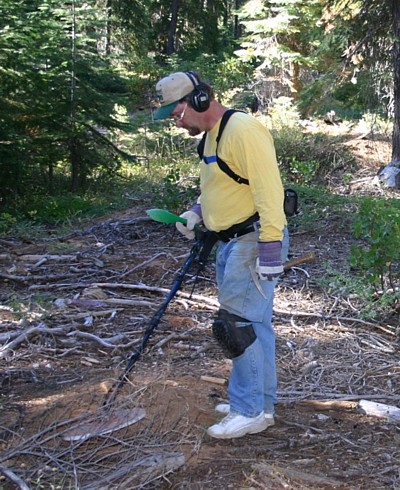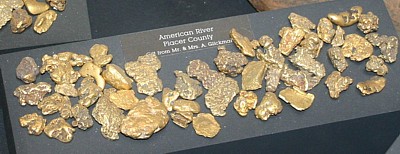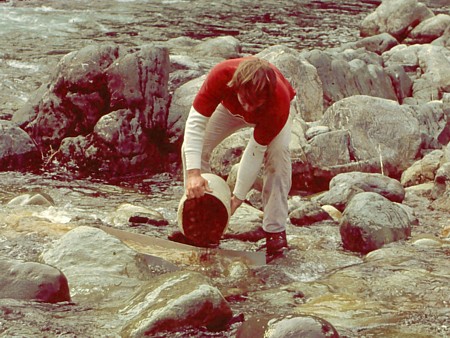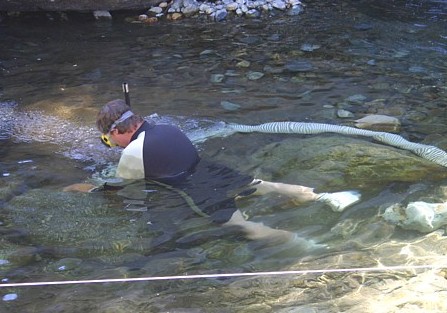Interested in learning about placer mining for gold nuggets? This is my page of introductory information on placer mining and how its done......
| Placer gold means gold that is in the form of loose individual grains which has eroded out of the host rock in mountains and hills freeing it so they can be recovered without further crushing of the host rock. This includes things such as gold flakes and nuggets. This is the type of gold which is of the greatest interest to individual prospectors. Placer gold has been mined from gravel deposits throughout the western US in many different types of environments, both forest and desert. Over 64% of the gold produced in California has come from placer deposits, while in Nevada, most of the gold has come from gold still within the original hard rock formations. In the early days, the rich, easily discovered, surface and river placers were mined throughout the West by individual miners using small scale methods from the 1850s through the 1860s. Where water was available, miners developed large hydraulic mines, using powerful water cannons to wash down whole hillsides. Beginning with the Sawyer decision in 1884, environmental concerns over the large amount of mud, silt and other debris dumped into adjoining streams by these operations led to increasing legal restrictions on this type of mining. Placer miners have also gone underground, drift mining for placer gold deposits in ancient channels and bench deposits. | ||
| . | ||
| Placer gold production declined after the best of those early discoveries were worked out, but the levels rose again with the invention of large-scale bucket line dredging. These are large-scale pieces of equipment which have a continuous chain of steel buckets that are used to dig gravels and then process them for their gold. The first successful bucket line gold dredge was introduced on the lower Feather River near Oroville in 1898. Since then, dredging has contributed a significant part of California’s total gold production. Use of these dredges spread and the method was successfully employed throughout the western states and Alaska. The reason so much of the West's gold was been mined from placers is that placer deposits are usually easier to locate than lode deposits. That is why still to this day individual prospectors normally place their main focus on placer gold. The gold can be recovered much more easily than the gold contained within hard rock deposits. Hard rock deposits usually require blasting to excavate the ore, and crushing to extract it from the rock. A lone prospector with a gold pan can verify the presence of placer gold in a gravel deposit in a short period of time. Small placers are also relatively easy to mine, as the gravels usually require far less processing than ore from lode mines. The exception is placers from drift mines where the ancient gravels are often tightly cemented and require crushing to extract the gold. |  | |
| Gravity separation remains the most widely used recovery method to extract placer gold. Gravity recovery equipment, including gold pans, sluice boxes, long toms, shaking tables, jigs, and amalgamation devices, have been used since the time of the California gold rush, and many present day operations still employ the same types of equipment. The major flaw of the gravity separation method is that very fine gold, often referred to as flour, flood, or gold dust, is lost in processing. Early miners sometimes recovered no more than 60% of assayed gold values when lots of fines were present. Moreover, it is likely that most remaining placer deposits have a higher percentage of fine gold than placers worked during the gold rush. With the current high price of gold, it is understandable, then, that today more care is given to the recovery of fine gold. In recent times a number of changes and new designs in gravity separation equipment have been developed. Most of these were developed outside the United States for the recovery of materials other than gold. Some of the new equipment has been successfully used to recover gold and some older designs have been modified and improved. Today, many types of equipment exist for the efficient recovery of placer gold. It is important to note that recovery techniques are often very site specific. A recovery system that collects a high percentage of fine gold from one deposit may not perform effectively with materials from a different deposit. Many factors, such as particle size, clay content, gold size distribution, mining methods, and character of wash water, affect the amount of gold recovered. Extensive experimentation and testing is usually required to design an optimum gold recovery in a commercial mining system. | ||
| . | ||
| The recovery of placer gold involves processing similar to the processing of most ores. First, the valuable material is separated from the valueless waste through concentration. The final concentrate, usually obtained by repeated processing, is smelted or otherwise refined into the final product. In general, the commercial concentration of placer gold ore consists of a combination of the following three stages: roughing, cleaning, and scavenging. For the small-scale or individual operator, fewer steps may be involved. The object of the initial concentration is to separate the raw ore into two products. Ideally, in placer gold recovery, all the gold will be in the concentrate, while all other material will be in the tailings. Unfortunately, such separations are never perfect, and in practice some gold remains in the tailings and is lost. Cleaning is the re-treatment of the rough concentrate to remove impurities. This process may be as simple as washing black sands in a gold pan. For commercial operations, mineral concentrates may go through several stages of cleaning before a final concentrate is produced. Devices, such as shaking tables are used in large operations specifically for cleaning. Concentrates are cleaned until the desired grade of purity is obtained. For the individual prospector, this usually means a gold product clean enough that it can either be sent to a refinery or sold to jewelers or mineral collectors. |  | |
| Many types of efficient placer gold recovery equipment are available today. For the small operator, the choice is usually determined based on the environment he desires to prospect in, as well as his spending budget. In desert environments, dry washers and metal detectors are the chief choices. Other water conserving devices may also be a possibility. For those with access to water in a close to their placer deposits, options like sluice boxes and small scale suction dredges can also be considered. The versatile gold pan gets used in almost all environments, although in dry environments one has to bring water and the tub to hold it in order to use the pan effectively. We will take a look at all of these devices and how they are use by the individual prospector and minor to recover gold flakes, dust and nuggets. | ||
| The cost of prospecting equipment used by individual prospectors covers quite a range. Small plastic gold pan can be purchased for less than $10. Top-of-the-line metal detectors designed to find gold cost over $4000. A large suction dredge may cost up to $10,000. Other equipment covers all levels in between. It is not necessary for the new prospector to start with the most expensive items. It is both sensible and reasonable to start off small, purchase some books to learn about how to prospect and have his equipment grow with his knowledge and abilities. So my suggestion is to give it a try, start out small and see how you like it.It's highly unlikely you will strike it rich, but if you work at it you will find some gold and have a lot of fun along the way. |  | |
 |  | |
Comments: 0
Post a Comment